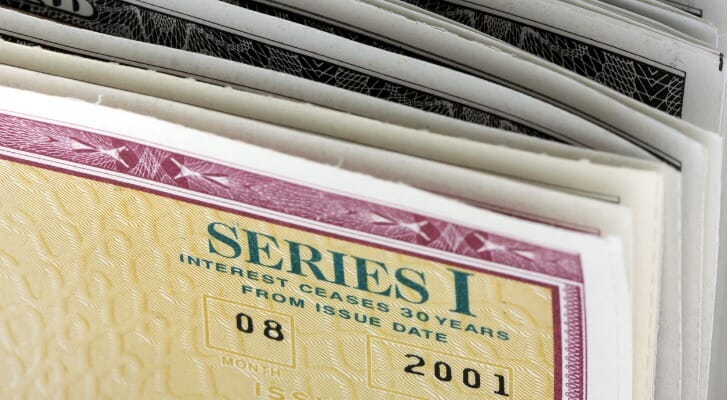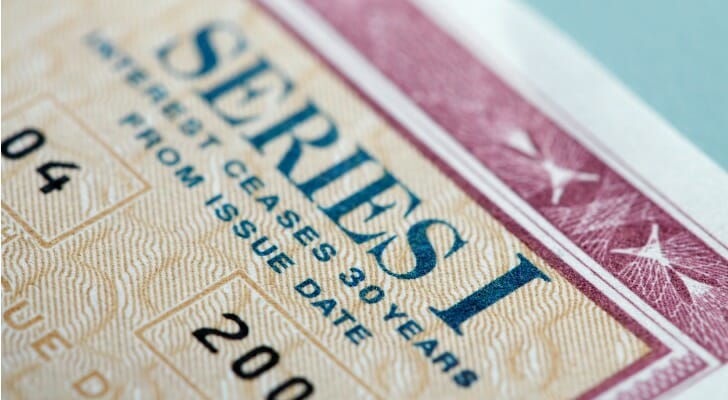Investors have until the end of the month to lock in a nearly 10% interest rate on U.S. Treasury Series I savings bonds before the current record high rate – actually higher than the rate of inflation – slips down.
The current rate on Series I savings bonds is 9.62%, which was set at the last six-month auction in May and is the highest rate the bonds have paid since they were introduced in 1998.
Consider working with a financial advisor as you seek a high interest rate on the fixed-income portion of your investment portfolio.
How Series I Savings Bonds Work
Series I bonds pay a fixed rate set by the Treasury as well as an added inflation rate, the Consumer Price Index for All Urban Consumers (CPI-U), that’s adjusted with each auction. Investors can purchase up to $10,000 in I bonds each year electronically from the government’s TreasuryDirect.gov website. Further, you may buy up to another $5,000 in paper I bonds using your federal income tax refund, meaning you can purchase up to $15,000 of I bonds each year. You may buy them in any denomination you choose.
To get the full rate, buyers need to hold the bonds for at least five years. The bonds can’t be redeemed for one year after purchase, and any bonds redeemed before five years forfeit the last three month’s of interest payments.
Interest income from the bonds is credited to the value of the bond, rather than being directly paid out to the bondholder. Interest is tax-free at the state and local level but is taxable on your federal income tax return. The tax can be paid when the bonds are redeemed or as the interest is credited during the life of the bond. Bonds sold to pay for qualified educational expenses can be redeemed tax-free.
The bonds have a 20-year maturity with another 10 years extended, giving them a lifetime of 30 years, with the combined interest rate changing every six months as the inflation portion is recalculated. The fixed rate potion of the bond, however, is locked in for life. In 1998, the fixed-rate portion of the bonds was set at 3.4%, meaning that savers who’ve held onto those bonds are getting an annual rate of 13.02%, paid on the first of each month.
How to Buy I Bonds
I bonds can be purchased only from the TreasuryDirect.gov website. Buyers need to create an account, a process many investors have criticized as complicated and clunky. Besides your personal information you’ll need to enter bank account and routing numbers, along with setting up a password and security questions. The bonds are issued electronically, and the minimum purchase amount is $25.
Investors can purchase up to another $5,000 in paper bonds using their federal income tax refunds, or $10,000 for a couple filing jointly. The purchase can be made only when you file your return, using IRS Form 8888, Allocation of Refund.
I bonds can be purchased for children by setting up a “minor account” linked from the purchaser’s own TreasuryDirect account. The account is custodial and can be accessed only by the purchaser. I bonds also can be purchased as a gift for anyone with a Social Security number, as long as the total of bonds purchased and credited to that Social Security number is less than $10,000 that year.
What Actually Happens on Nov. 1?
The coming Nov. 1 auction rate is expected to be somewhere around 6.5%, a rate that’s still better than the best bank savings accounts or certificates of deposit. I bond interest is compounded semi-annually.
That rate could go higher if Treasury Secretary Janet Yellen decides to adjust the fixed rate component, which has been 0% since early 2020, when the Federal Reserve’s funds rate was at 0% to 0.25%. That rate now is 3% to 3.25%. The Treasury recommends purchasing bonds by Oct. 28 to be sure that they’re issued by Oct. 31.
Bottom Line
The clock is ticking on one of safest and most generous fixed-income securities in the world, the U.S. Treasury Series I savings bond. These bonds currently offer a record-high 9.62% interest rate – higher than the current CPI-U.
That rate, however, is poised to decline, so if you want to get in on that rate it’s important to act before Nov. 1, 2022.
Tips on Fixed-Income Securities
- A financial advisor can help you pick fixed-income securities that complement your investment goals, timeline and risk profile. Finding a financial advisor doesn’t have to be hard. SmartAsset’s free tool matches you with up to three financial advisors who serve your area, and you can interview your advisor matches at no cost to decide which one is right for you. If you’re ready to find an advisor who can help you achieve your financial goals, get started now.
- Use our no-cost investment calculator to get a quick estimate of how your investments could be expected to grow over time.
Photo credit: ©iStock.com/larryhw, ©iStock.com/DNY59, ©iStock.com/Galina Zhigalova


